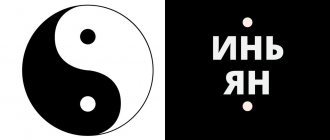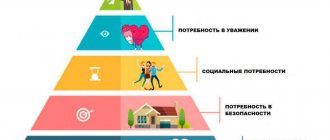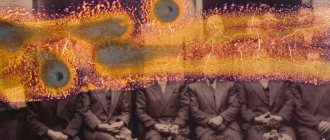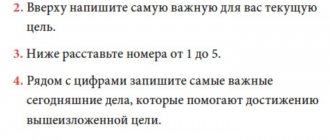In this article we will talk about the Yin and Yang symbol and what meaning it has.
We have all certainly seen this sign, in which black and white colors are opposed to each other, but at the same time, as if smoothly flowing from one to the other. The lines of their connection are rounded and smooth, there is no sharp transition separating black and white. What does this all mean?
A means this popular symbol, if we summarize all the concepts included in it, the eternal struggle and fusion of opposites.
Yin-Yang symbol image
- Black on the symbol sign indicates Yin.
- Yang is indicated in white on the sign.
A circle symbolizing infinity, conventionally divided into two parts - this is how this sign appears.
Yin Yang
- Conventionally, because the black and white halves are not separated by diameter, but are smoothly rounded, entering each other.
- In each of the parts there is a small circle of a color contrasting with the general background - this is a symbol of the presence of opposites in everything.
- The wavy curves at the point of separation of the two parts speak of the circular movement of Yin and Yang, now advancing and now retreating in front of each other, like sea waves rolling onto the shore and retreating back into the sea.
Yin-yang in the apartment and in the workplace
Symbols are also present indoors, yin helps to relax, and yang helps to work. In these rooms, a balance between energies should also be maintained. If it is violated, it will be almost impossible to successfully engage in any business. The difference between the beginnings is allowed only in small quantities and is determined by what kind of activity will take place here. It is necessary to strengthen masculine energy in the workplace. For this:
- the room must be well ventilated;
- tools and equipment must be clean;
- put a small aquarium or fountain;
- increase the brightness of lighting;
- the walls of the room should not be white, if this cannot be changed, then decorate them with paintings and flowers;
- you can turn on music;
- hang a clock on the wall.
The last two points are explained by the fact that sounds enhance active energy. At the same time, Yang energy should not suppress Yin, but only prevail over it.
If you work at home, then these tips are also suitable for your office. In the case when you work and relax in the same room, you should somehow delimit it into two separate spaces: for work and for rest. Yin energy should reign in the bedroom and relaxation areas. Generally speaking, both in the apartment and at work, there should be a little more masculinity than feminine. This will stimulate you to take action and new achievements.
Where did the Yin and Yang symbol come from?
There is a version (in particular, it is adhered to by a doctor of historical sciences, an in-depth study of the culture of the East, Alexey Maslov) that at the very beginning of our era this symbol came from Buddhism. There is also a hypothesis that initially the sign symbolized the illumination and darkness of mountain slopes, periodically changing their position.
The famous “Book of Changes” uses Yin and Yang precisely to demonstrate contrast: white and black, soft and hard. The further the philosophical tenets of Taoism developed, the more polar the concepts embedded in these two symbols became. They were used in almost all teachings and areas of Chinese philosophy. The dual nature of Yin-Yang has become a fundamental principle not only in philosophy, but also in medicine, music, and various sciences of this country.
CONTENT
- 1 Linguistic aspects 1.1 Characters
- 1.2 Pronunciations and etymologies
- 1.3 Values
- 1.4 Toponymy
- 1.5 Borrowings
- 2.1 Chinese gender roles
- 5.1 I Ching
- 7.1 Footnotes
The essence of the Yin-Yang symbol
Chinese sages highlight two aspects that are embedded in the Yin-Yang symbol.
- First: nothing is permanent, changes are constantly happening in the world.
- Second : contrast not only demonstrates the difference, but also helps to better understand the opposite sides in comparison and complement each other.
After all, how can you understand what darkness is if you don’t know what light is. The opposite is the same. This means that creating and maintaining such a balance in all spheres of life is the main goal of the entire existence of humanity.
Charms
Yin brings calm, yang brings energy, it is not surprising that this sign is often depicted on amulets, pendants, and tattoos. It nourishes a person energetically and protects him from everything bad. Therefore, its use goes back centuries. Both principles are present in every person; the symbol tries to balance them and make the person whole and harmonious.
In this article we looked at how the ancient Eastern law of Yin Yang can help us in everyday life. Namely, taking into account the presence of masculine and feminine principles during the construction of a house, during its interior decoration, using additional items, you can create a good atmosphere for work or a comfortable environment for relaxation. Amulets will also help us live an active, rich and harmonious, calm life. But the most important thing is to strive to achieve a balance between such different and inseparable energies, that is, to pay attention to different areas of life, and develop opposite, but useful qualities. Then we will experience prosperity, well-being, love, health and good luck in all endeavors.
Elements of Yin and Yang
It cannot be said that one of these two principles represented in Yin-Yang is positive, and the other is negative. How to determine what is first and what is second - earth or sky? They are opposite to each other, but, for example, during a rainstorm they merge into one.
It was this merger that became the basis for the emergence of the concept of five elements that constantly interact. One feeds the other and thus creates it, forming a cyclical process. But on the contrary, each element to some extent “extinguishes” the other, destroying or weakening it.
- The tree symbolizes the beginning. This can refer to anything: the beginning of the day, the beginning of life, etc. And, of course, the beginning in Chinese philosophy is the East. This element is made weaker by Fire and Earth, stronger by the Water and Metal that nourishes it.
- Fire . Just as the morning is followed by the day, so the tree is followed by the fire it gives birth to. It is strengthened by Earth and Wood, and weakened by Water and Metal, respectively.
- The earth is born by fire. Perhaps we are talking about fertilizing it with ashes. The earth symbolizes the middle, associated with the yellow color of a mature ear. It is weakened by Water and Metal, and on the contrary, Fire and Wood make the Earth stronger.
- Metal is the next element that corresponds to the autumn of the year or life. This element is weakened by Wood and Water, strengthened by Earth - black and green. Earth and Fire flow in.
- Water is the last of the five elements generated by Metal. The end of the cycle, calm and night - this is how this element is interpreted. Weakened by Wood and Fire, strengthened by Earth and Metal, Water is associated with winter, which turns into spring, i.e. in Tree. The cycle is over.
It should be noted that each of the elements is dual in nature and includes two more opposites: the feminine and masculine, which are also impossible without each other.
Ways to Increase Yin Energy Levels
Modern society and the education system require women to demonstrate masculine qualities. However, this often leads to family problems and illnesses. For example, a woman (Yin) is fire and a man (Yang) is fire. Only one will be able to realize his nature, and he will lack the lunar feminine energy for restoration, which only a woman can give.
The predominant energies depend on the state and well-being of the woman, on her thoughts and emotions. The development of Yin is beneficially influenced by calmness, a patient attitude towards other people, communication in order to share news, joys, problems, etc. with people. However, it should be understood that the basic need is security. Only by understanding the absence of any threat is a woman able to patiently keep the hearth and hearth, filling it with her calm energy.
The main points that determine the Yin level are the following:
- cleanliness (the decoration of the house, the condition of clothes and the cleanliness of dishes affect the level of feminine energy, in addition, the purity of thoughts and relationships within the family plays an important role);
- beauty (a woman needs beauty in everything that surrounds her: home, clothes, garden, dishes, emotions; from a man’s point of view, investing in beauty will be as justified as possible, since only a woman filled with energy can restore his strength);
- care (showing participation in the affairs of other people and feeling cared for by others helps a woman feel safe and filled with energy, giving it to loved ones);
- trust (cultivating the ability to trust people is an important point for filling with energy; if there is no trust, then the energy is wasted on protection, not on happiness);
- compliments (praise has a positive effect on a woman of any age, increasing her energy level);
- hospitality (the tendency to treat food is inherent in a woman by nature; in this process, a woman exchanges energy, offering gifts to guests, and is filled with the feminine principle);
- handicrafts (creative activities develop intuition and the ability to subtly sense beauty, which leads to the development of yin energy).
A measured pace of life without shocks and stress helps a woman maintain harmony of energy within herself and thereby fill the home with happiness and joy.
Yin and Yang Projections
Concepts identical to Yin-Yang, as a fusion of opposites, are present in many teachings and philosophies. For example, in Hinduism there is a character Purusha, who is interpreted as a man, a masculine principle. Along with him, one of the characters in Samkhya is Prakriti, who embodies the feminine essence. At the same time, both heroes symbolize the spiritual and material components of existence.
Or let's look into the distant past of the emergence of Scandinavian runes. One of them, Algiz, symbolizes the movement towards the light and at the same time the masculine principle. If the rune is turned over, Ir appears, having a feminine principle and striving for darkness, the otherworldly, and death.
Kabbalistic teaching speaks of the Ohr and the Kli, which is also the interaction of two principles and is compared in the philosophy of Kabbalah with light and vessel, spirit and matter. If we talk about more modern theories, then in the last century, the Swiss psychiatrist Gustav Jung introduced the terms anima and animus into use, meaning by them the same feminine principles (but in the psyche of a man) and, accordingly, masculine principles in the feminine. And even Hegel’s materialist dialectics, speaking about the unity and struggle of opposites, essentially confirms the theory of the teachings of Yin and Yang.
Feminine and masculine principles in nature
In accordance with the teachings of Feng Shui, our land is divided into two types: water and mountain. Symbols are present in nature: yin - mountains, yang - water. Since the mountain represents static immobility and, in general, mountains are the skeleton of our planet, it is not surprising that they embody the yin symbol. But the water in the seas, oceans, rivers, waterfalls is constantly in motion, which means it carries more active yang energy.
But mountains, in turn, are also divided into two types: Yin and Yang. The former include those whose peaks are sharp, and the yang mountains are those with a smoother, rounded peak. Likewise, water in reservoirs can carry yin or yang energy. The feminine principle predominates in high waterfalls and fast rivers, and the masculine principle predominates in flowing lakes and calm rivers. Yin water is characterized by destruction, and Yang water is characterized by calm and tranquility.
How to use the yin-yang law when building a house?
- In areas where mountains predominate and water is scarce, energy decreases. The opposite situation: an excess of water and a lack of mountains leads to an increase in energy, and ultimately to the inability to control it. Therefore, when choosing a site for housing construction, you need to pay attention to those places where the symbols are not suppressed, but are equalized: equal parts yin (mountains) and yang (water).
- Also, you should not start building in places where there are a large number of trees and bushes.
- A house located near places that bear the stamp of death: a cemetery, a prison, a hospital is under the influence of yin energy, which will suppress activity and energy.
- However, you should not jump to the conclusion that an area that carries yang energy will make your life happier. Masculinity will cause life events to pass very quickly. Therefore, when choosing an area to build a house, it is very important to have a balance between the two principles.
Our life in the Yin-Yang style
Let's look around. Intuition, opposed to rationalistic thinking, is the feminine Yin and the masculine Yang. The power of the sun and the soft flow of water, the warmth of the south and the cold of the north, creation and contemplation - all this is Yin and Yang.
Good and evil, day and night - our world is completely woven from opposite concepts, but only by connecting with each other do they become a single whole. Like, in fact, a man and a woman, each of which contains both Yin and Yang. The main thing is to achieve harmony and balance between them, which this ancient symbol constantly reminds us of.
Yin Yang Products
If you were given (or you bought yourself) a similar pendant or coin, refrain from immediately putting on the talisman. First, rinse it thoroughly or cover it with salt for a while - this way you will cleanse it of random foreign energy. And then influence it with the forces of the element to which you belong: dip it in water, hold it in a flame, sprinkle it with earth or expose it to a breath of wind. Now this is really yours, and only your talisman.
Time of dominance of each energy
Just as in a symbol the circle is divided into equal parts, so in life the time is divided when one or another principle dominates. Depending on the time of day, phases of the moon, seasons, yang and yin replace each other. Let's take a closer look:
- It is light during the day, so yang energy reigns, reaching its maximum at lunchtime. When night falls, yin wakes up, being most active at midnight.
- The phases of the moon also affect the distribution of energies. The full moon is the time of the masculine, and the new moon is the time of the feminine. Accordingly, during the full month, people become more energetic and plan things better at this time, and during the new moon, creative endeavors and reflections are good.
- Spring and summer are sunny seasons, so they are ruled by yang, but winter and autumn are ruled by yin. But there is one peculiarity: children born in spring or summer carry more Yin energy, and those born in the cold season carry Yang energy. There is an opinion: during which period most of the pregnancy occurred, such energy will prevail in the child.
Links[edit]
Footnotes [edit]
- "The Hidden Meanings of Yin and Yang - John Bellamey". TED-Ed. Retrieved August 2, 2013.
- Jump up
↑ Feuchtwang, Stephan (2016).
Religions in the Modern World: Traditions and Transformations
. New York: Routledge. paragraph 150. ISBN 978-0-415-85881-6. - Feuchtwang, Sephan. "Chinese Religions". Religions in the Modern World: Tradition and Transformation, Third ed., Routledge, 2021, pp. 150-151.
- Porkert (1974). Theoretical foundations of Chinese medicine. MIT Press. ISBN 0-262-16058-7.
- Georges Osawa (1976). A unique principle. ISBN 978-0-918860-17-0- via Google Books.
- Taylor Latener, Rodney Leon (2005). The Illustrated Encyclopedia of Confucianism
.
2
. New York: Rosen Publishing Group. item 869. ISBN 978-0-8239-4079-0. - Karlgrens, Grammata Serica Recensa
, Museum of Far Eastern Antiquities, 1957, 173, 188. - ↑
Lee, Fang-Kuei, "Studies in Archaic Chinese", translated by Gilbert L. Mattos,
Monumenta Serica
31, 1974: 219–287. - William H. Baxter, Handbook of Ancient Chinese Phonology
, Mouton de Gruyter, 1992. - Schuessler, Axel, ABC Etymological Dictionary of Ancient Chinese
, University of Hawaii Press, 2007, 558, 572. - Baxter & Sagart (2014), pp. 326-378.
- Schuessler, Axel, ABC Etymological Dictionary of Ancient Chinese
, University of Hawaii Press, 2007. pp. 168, 180, 558. - John DeFrancis, ed., ABC Chinese-English Comprehensive Dictionary
, University of Hawaii Press, 2003, 1147, 1108. - Rolf Stein (2010), Rolf Stein's Tibetica Antiqua: with additional material
, Brill, p. 63. - Arnoldus Montanus, Atlas Chinensis: Being relatively noteworthy passages in two embassies from the East India Company of the United Provinces to Vice Roy Singlamong General Taising Lipovi and Konchi, Emperor, Thomas Johnson
, tr. J. Ogilby, 1671, 549: “The Chinese declare by these strokes how much each Form or Sign receives from the two Principles of Yin or Yang above mentioned.” - William Jones Boone, "Defense of an Essay on the Proper Translation of the Words Elohim and θεός into Chinese," Chinese Repository
XIX, 1850, 375: "... when in the Yih-King (or Book of Diagrams) we if we read of the Great Extremity, it means "that the Great Extreme is in the midst of the active-passive primordial substance (Yin-Yang), and that it is not external to or separate from Yin-Yang." - ↑
Carl Jung, "Aion: Studies in the Phenomenology of the Self", in
The Collected Works of C.G.
Jung" , tr.
RFC Hull, Volume 9, Part 2, Page 58 "" [The vision of the "Ascension of Isaiah"] could easily be a description of the true yang-yin relationship, a picture that is closer to the actual truth than privatio boni
. Moreover, it in no way harms monotheism, since it unites the opposites of justice, and yang and yin are united in Tao (which the Jesuits quite logically translated as “God”).” - For example, Huainanzi
says: “Now lumber is not as important as timber; the forest is not as important as the rain; rain is not as important as yin and yang; yin and yang are not as important as harmony; and harmony is not as important as the Path. (12,材不及林,林不及雨,雨,陰陽不及和,和不及道; tr. Major et al. 2010, 442). - ^ ab Roger T. Ames, " Yin
and
Yang
", in
Encyclopedia of Chinese Philosophy
, ed. Antonio S. Cua, Routledge, 2002, 847. - ^ab Needham, Joseph; Science and Civilization in China Volume 2: History of Scientific Thought; Cambridge University Press; 1956
- [1]
- Mueller, Charles. "Daode Ching". Retrieved March 9, 2021.
- Robin R. Wang "Yinyang (Yin-Yang)". Internet Encyclopedia of Philosophy
. Retrieved March 9, 2021. - Nyoiti Sakurazawa and William Dufty (1965) Y'all Sanpaku
, page 33 - China
- Osgood, Charles E. "From Yang and Yin to and or but." Language 49.2 (1973): 380–412. JSTOR
- Lee CL. A brief sketch of the history of Chinese medical conditions with special acupuncture. Perspect Biol Med. Autumn 1974; 18 (1): 132-43.
- ↑
The text of
the I Ching
has its origins in a Western Zhou divination text called
the Changes of Zhou
(ì
Zhōu yì
).
Various modern scholars have proposed dates ranging between the 10th and 4th centuries BC for assembling the text roughly in its current form. Nilan, Michael (2001), Five Confucian Classics
(2001), p. 228. - Giovanni Monastra: "Yin-yang" among the Insignia of the Roman Empire? Archived 2011-09-25 at the Wayback Machine", "Sofia" Vol. 6, No. 2 (2000)
- "Late Roman shield examples - Magister Peditum". www.ne.jp.
_ - ↑
Helmut Nickel: "The Dragon and the Pearl",
Metropolitan Museum of Art Magazine,
Vol. 26 (1991), p. 146, Fn. 5 - Hughes, Kevin (2020). Introduction to Yin-Yang Theory
. Independent. ISBN 979-8667867869. - Woolidge, Dougie (June 1997). "T'AI CHI International Journal of Tai Chi Chuan Vol. 21 No. 3." Tai Chi
. Wayfarer Publications. ISSN 0730-1049.
Works Cited[edit]
- Baxter, William H.; Sagart, Laurent (2014). Old Chinese: New Reconstruction
. Oxford: Oxford University Press. ISBN 978-0-19-994537-5.
Group dualism
Source: @in_yan_group
In 2007, in the seventh season of the popular music show “Star Factory,” a new group was formed, which included project participants Tatyana Bogacheva and Sergei Ashikhmin, as well as participants who left it shortly before the last reporting concert—Yulia Parshuta and Artem Ivanov.
Source: @in_yan_group
The show's producer, Konstantin Meladze, introduced the new team as "Yin-Yang". This unusual name was borrowed from the philosophy of Ancient China to emphasize that, despite different characters, inner worlds and musical preferences, guys can work together and create hits.
Do not miss
- Do not miss
The Dynamite group 22 years later: what the soloists are doing today and how their personal lives turned out
The black and white image of the artists was also distinctive. The group’s first single, “Little by little,” which immediately became a hit and was in rotation on radio and television. In the final of the show, “Yin-Yang” performed a new composition “Save Me” and took third place, sharing it with the group “BiS”. For several years, the soloists worked under the leadership of Konstantin Meladze and released such hits as “Karma”, “Don’t care”, “Kamikaze”, “Don’t let go of my hand” and others.
Source: @in_yan_group
In 2011, Julia left the team. It turned out that the singer did not have very good relationships with her colleagues, and besides, she dreamed of a solo career. Five years later, Sergei Ashikhmin also left the group. Tatyana Bogacheva and Artem Ivanov remain permanent soloists, but today each of them is also pursuing a solo career.
Notes[ | ]
- https://ec-dejavu.ru/t-2/Taoism.htm (inaccessible link)
- Daniel Reid.
A Complete Guide to Chi-Gung: The Principles and Practice of the Ancient Chinese Path to Health, Vigor, and Longevity. - Shambhala Publications (English) (Russian, 2000. - P. 11. - ISBN 978-0-8348-2374-7. - Shiro Matsuoki
The Beginning of Yin and Yang Archived copy dated February 4, 2010 on the Wayback Machine (inaccessible link since 05/11/2013 [3132 days]) // Applied macrobiotics. - Henry B. Lin.
Chinese Health Care Secrets: A Natural Lifestyle Approach. - Llewellyn Worldwide (English) (Russian, 2000. - P. 14. - ISBN 978-1-56718-434-1. - Editors of Encyclopaedia Britannica.
Shen
(undefined)
.
Britannica
. Date accessed: April 25, 2021. - Stephen Little, et al. Taoism and the Arts of China. (Chicago: The Art Institute of Chicago, in association with University of California Press, 2000), p. 131.
- The Chinese Cosmos: Basic Concepts* (English). Asia for Educators, Columbia University
. Date accessed: March 27, 2021. - Kuchera S.
Tai Chi
(undefined)
.
Sinology.Ru
. Date accessed: April 26, 2021. - Miller, J.
Daoism.
c. 54. Archived copy (unspecified)
(inaccessible link). Access date: February 19, 2014. Archived December 23, 2014.











